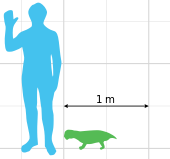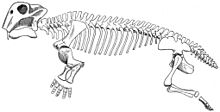Lystrosaurus
| Lystrosaurus | |
|---|---|

| |
| L. hedini skeletal mount from the Natural history museum of Zürich | |
| Scientific classification | |
| Domain: | Eukaryota |
| Kingdom: | Animalia |
| Phylum: | Chordata |
| Clade: | Synapsida |
| Clade: | Therapsida |
| Suborder: | †Anomodontia |
| Clade: | †Dicynodontia |
| Family: | †Lystrosauridae |
| Genus: | †Lystrosaurus Cope, 1870 |
| Species | |
Lystrosaurus (
As a dicynodont, Lystrosaurus had only two teeth (a pair of tusk-like canines), and is thought to have had a horny beak that was used for biting off pieces of vegetation. Lystrosaurus was a heavily built, herbivorous animal. The structure of its shoulders and hip joints suggests that Lystrosaurus moved with a semi-sprawling gait. The forelimbs were even more robust than the hindlimbs, and the animal is thought to have been a powerful digger that nested in burrows.
Lystrosaurus survived the
History of discovery

Dr. Elias Root Beadle, a Philadelphia missionary and avid fossil collector, discovered the first Lystrosaurus skull. Beadle wrote to the eminent paleontologist Othniel Charles Marsh, but received no reply. Marsh's rival, Edward Drinker Cope, was very interested in seeing the find, and described and named Lystrosaurus in the Proceedings of the American Philosophical Society in 1870.[3] Its name is derived from the Ancient Greek words listron "shovel" and sauros "lizard".[4] Marsh belatedly purchased the skull in May 1871, although his interest in an already-described specimen was unclear; he may have wanted to carefully scrutinize Cope's description and illustration.[3]
Plate tectonics
The discovery of Lystrosaurus fossils at Coalsack Bluff in the Transantarctic Mountains by [2] Edwin H. Colbert and his team in 1969–70 helped support the hypothesis of plate tectonics and strengthen the theory, since Lystrosaurus had already been found in the lower Triassic of southern Africa as well as in India and China.[5][6]
Distribution and species
Lystrosaurus fossils have been found in many
Species found in Africa

Most Lystrosaurus fossils have been found in the
L. maccaigi is the largest and apparently most specialized species, while L. curvatus was the least specialized. A Lystrosaurus-like fossil, Kwazulusaurus shakai, has also been found in South Africa. Although not assigned to the same genus, K. shakai is very similar to L. curvatus. Some paleontologists have therefore proposed that K. shakai was possibly an ancestor of or closely related to the ancestors of L. curvatus, while L. maccaigi arose from a different lineage.[8] L. maccaigi is found only in sediments from the
L. murrayi and L. declivis are found only in Triassic sediments.[8]
Other species
Lystrosaurus georgi fossils have been found in the Earliest Triassic sediments of the Moscow Basin in Russia. It was probably closely related to the African Lystrosaurus curvatus,[7] which is regarded as one of the least specialized species and has been found in very Late Permian and very Early Triassic sediments.[8]
L. murrayi, in addition to two undescribed species presently assigned to L. curvatus and L. declivis, is known from the Early Triassic Panchet Formation of the Damodar Valley and the Kamthi Formation of the Pranhita-Godavari Basin in India.[10] Seven Lystrosaurus species have been described from the Early Triassic Jiucaiyuan, Guodikeng and Wutonggou formations of the Bogda Mountains in Xinjiang, China, although it is possible that only two (L. youngi and L. hedini) are valid; unusually, no Chinese Lystrosaurus specimens are known below the Permian-Triassic boundary in this region.[11][12] L. curvatus, L. murrayi, and L. maccaigi are known from the Fremouw Formation in the Transantarctic Mountains of Antarctica.[13]
Description

Lystrosaurus was a dicynodont therapsid, between 0.6 to 2.5 m (2 to 8 ft) long with an average of about 0.9 m (3 ft) depending upon the species.[14]
Unlike other therapsids, dicynodonts had very short snouts and no teeth except for the
Features of the skeleton indicate that Lystrosaurus moved with a
Mummified specimens recovered from the Karoo Basin and described in 2022 revealed that Lystrosaurus had dimpled, leathery, and hairless skin.[17][18]
Paleoecology
Dominance of the Early Triassic

Lystrosaurus is notable for dominating southern Pangaea for millions of years during the Early Triassic. At least one unidentified species of this genus survived the end-Permian mass extinction and, in the absence of predators and herbivorous competitors, went on to thrive and re-radiate into a number of species within the genus,[19] becoming the most common group of terrestrial vertebrates during the Early Triassic; for a while, 95% of land vertebrates were Lystrosaurus.[19][20] This is the only time that a single species or genus of land animal dominated the Earth to such a degree.[21] A few other Permian therapsid genera also survived the mass extinction and appear in Triassic rocks—the therocephalians Tetracynodon, Moschorhinus, Ictidosuchoides and Promoschorhynchus—but do not appear to have been abundant in the Triassic;[8][22] complete ecological recovery took 30 million years, spanning the Early and Middle Triassic.[23]
Several attempts have been made to explain why Lystrosaurus survived the Permian–Triassic extinction event, the "mother of all mass extinctions",[24] and why it dominated Early Triassic fauna to such an unprecedented extent:

- Growth marks in fossilized tusks suggest that Lystrosaurus living in Antarctica ~250 Mya could enter a prolonged state of torpor analogous to hibernation. This could be the oldest evidence of a hibernation-like state in a vertebrate animal and indicates that torpor arose in vertebrates before mammals and dinosaurs evolved.[25][26][27]
- One of the more recent theories is that the extinction event reduced the atmosphere's oxygen content and increased its neural spines (projections on the dorsal side of the vertebrae) that gave greater leverage to the muscles that expanded and contracted its chest. However, there are weaknesses in all these points: the chest of Lystrosaurus was not significantly larger in proportion to its size than in other dicynodonts that became extinct; although Triassic dicynodonts appear to have had longer neural spines than their Permian counterparts, this feature may be related to posture, locomotion or even body size rather than respiratory efficiency; L. murrayi and L. declivis are much more abundant than other Early Triassic burrowers such as Procolophon or Thrinaxodon.[8]

- The suggestion that Lystrosaurus was helped to survive and dominate by being semi-aquatic has a similar weakness: although temnospondyls become more abundant in the Karoo's Triassic sediments, they were much less numerous than L. murrayi and L. declivis.[8]
- The most specialized and the largest animals are at higher risk in mass extinctions; this may explain why the unspecialized L. curvatus survived while the larger and more specialized L. maccaigi perished along with all the other large Permian herbivores and carnivores.[8] Although Lystrosaurus generally looks adapted to feed on plants similar to Dicroidium, which dominated the Early Triassic, the larger size of L. maccaigi may have forced it to rely on the larger members of the Glossopteris flora, which did not survive the end-Permian extinction.[8]
- Only the 1.5 m (5 ft)–long therocephalian archosauriform Proterosuchus appear to be large enough to have preyed on the Triassic Lystrosaurus species, and this shortage of predators may have been responsible for a Lystrosaurus population boom in the Early Triassic.[8]
- According to Benton, "Perhaps the survival of Lystrosaurus was simply a matter of luck".[19]
See also
- Evolution of mammals – Derivation of mammals from a synapsid precursor, and the adaptive radiation of mammal species
- Lists of synapsids
References
- ISBN 9780908407583.
- ^ Damiani, R. J.; Neveling, J.; Modesto, S.P. & Yates, A.M. (2004). "Barendskraal, a diverse amniote locality from the Lystrosaurus assemblage zone, Early Triassic of South Africa". Palaeontologia Africana. 39: 53–62.
- ^ ISBN 978-0-618-08240-7.
- ISBN 978-0-19-910207-5.
- ^ Naomi Lubick, Investigating the Antarctic, Geotimes, 2005.
- ISBN 9781118786352.
- ^ S2CID 59028100. Archived from the original(PDF) on 2008-12-19. Retrieved 2008-07-07.
- ^ doi:10.1111/j.1502-3931.2007.00011.x. Full version online at "Lystrosaurus species composition across the Permo–Triassic boundary in the Karoo Basin of South Africa" (PDF). Archived from the original(PDF) on 2008-09-10. Retrieved 2008-07-02.
- ^ Grine, F.E.; Forster, C.A.; Cluver, M.A. & Georgi, J.A. (2006). Amniote paleobiology. Perspectives on the Evolution of Mammals, Birds, and Reptiles. University of Chicago Press. pp. 432–503.
- .
- ISSN 1464-343X.
- PMID 33735263.
- JSTOR 1304463.
- ^ "Lystrosaurus | Fossils & Facts". Encyclopedia Britannica. Retrieved 2019-03-18.
- ISBN 978-0-632-04444-3.
- ISBN 978-0-520-24209-8.
- S2CID 251781291.
- ^ "These Fossil Mummies Reveal a Brutal World Long Before T. Rex Lived". 20 September 2022.
- ^ ISBN 978-0-500-28573-2.
- ^ a b [1] Archived October 12, 2007, at the Wayback Machine
- ^ BBC: Life Before Dinosaurs
- S2CID 129242450.
- PMID 18198148.
- ISBN 978-0-231-07467-4.
- ^ "Fossil evidence of 'hibernation-like' state in 250-million-year-old Antarctic animal". phys.org. Retrieved 7 September 2020.
- ^ "Fossil suggests animals have been hibernating for 250 million years". UPI. Retrieved 7 September 2020.
- PMID 32855434..
 Text and images are available under a Creative Commons Attribution 4.0 International License
Text and images are available under a Creative Commons Attribution 4.0 International License
